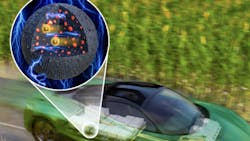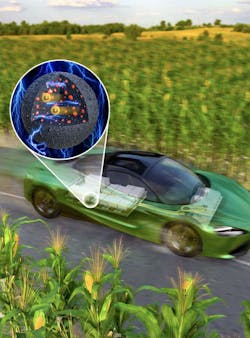Silicon-Carbon Anodes Fabricated with Corn Starch Could Double EV Driving Range
Electric vehicles (EVs) typically rely on in lithium-ion batteries that use graphite anodes. Silicon anodes potentially have 10X the capacity of graphite anodes, but silicon alone doesn’t stand up to the cycling demands of rechargeable batteries—its volume expands, causing its surface to crack. As a consequence, storage capacity decreases dramatically during charge/discharge cycles and the necessary capacity can’t be held over time.
Recently, researchers at the Korea Institute of Science and Technology (KIST) in South Korea proposed using waste corn starch in a low-cost and scalable approach to producing silicon-carbon (Si-C) hybrid composite anodes with four times the battery capacity of a similar graphite anode battery. Better still, the Si-C anodes maintain stability over 500 recharge cycles.
Developed by Dr. Hun-Gi Jung and his team at the Centre for Energy Storage Research at KIST, the technique promises to enable rapid charging—more than 80% capacity in only five minutes. When applied to batteries for electric vehicles, the new material is projected to more than double EV driving range.
From Starch to Carbon Balls
At the risk of oversimplification, the team dissolved corn and sweet potato starch in water, mixed in oil and silicon, and heated up the concoction employing the same simple thermal process used for frying food (but using cyclopropane in the heating process) to produce the silicon-carbon composites. The tiny carbon spheres keep the silicon from expanding during charge and discharge cycles.
The Si-C hybrid composite is comprised of silicon nanoparticles embedded in micron-sized amorphous carbon balls. The carbon matrix tightly surrounds the silicon nanoparticles providing high electronic conductivity and significantly decreasing the stress/strain of the material during multiple charge-discharge cycles.
The Si-C hybrid composite anode demonstrates a capacity of 1800 mAh/g (graphite anode materials check in at 360 to 1,530 mAh/g), excellent cycling stability with capacity retention of 80% over 500 cycles, and fast charge-discharge capability of 12 minutes. Moreover, the composite anode is reported to exhibit good acceptability in practical lithium-ion batteries assembled with commercial cathodes.
Dr. Jung explained that the use of common everyday materials means their technique is “highly likely” to be commercialized and mass-produced.
The new KIST research also could represent a significant advance with regard to developing a more environmentally friendly EV battery. As a bio-based sustainable alternative, the new material works around environmental issues related to graphite mining. In addition to releasing fine graphite particles into the atmosphere, graphite powder spillages can cause soil contamination and have a harmful effect on plant and animal life.
Meanwhile, in the U.S., silicon also has drawn attention as a next-generation anode material for the development of long-range electric vehicles. The Department of Energy is working with national laboratories to eliminate barriers to implementing silicon-based anodes in lithium-ion batteries through the Silicon Anode Consortium.
Funded by the U.S. Department of Energy’s Vehicle Technologies Office, the consortium is investigating the foundational science related to the initial chemical interactions of organic electrolytes with silicon interfaces with the goal of developing full electrode chemistry. The consortium includes the National Renewable Energy Laboratory (NREL), Argonne, Sandia, Oak Ridge, and Lawrence Berkeley national laboratories.
The full paper, “Nano/Microstructured Silicon-Carbon Hybrid Composite Particles Fabricated with Corn Starch Biowaste as Anode Materials for Li-Ion Batteries” was published in the American Chemical Society publication Nano Letters.

